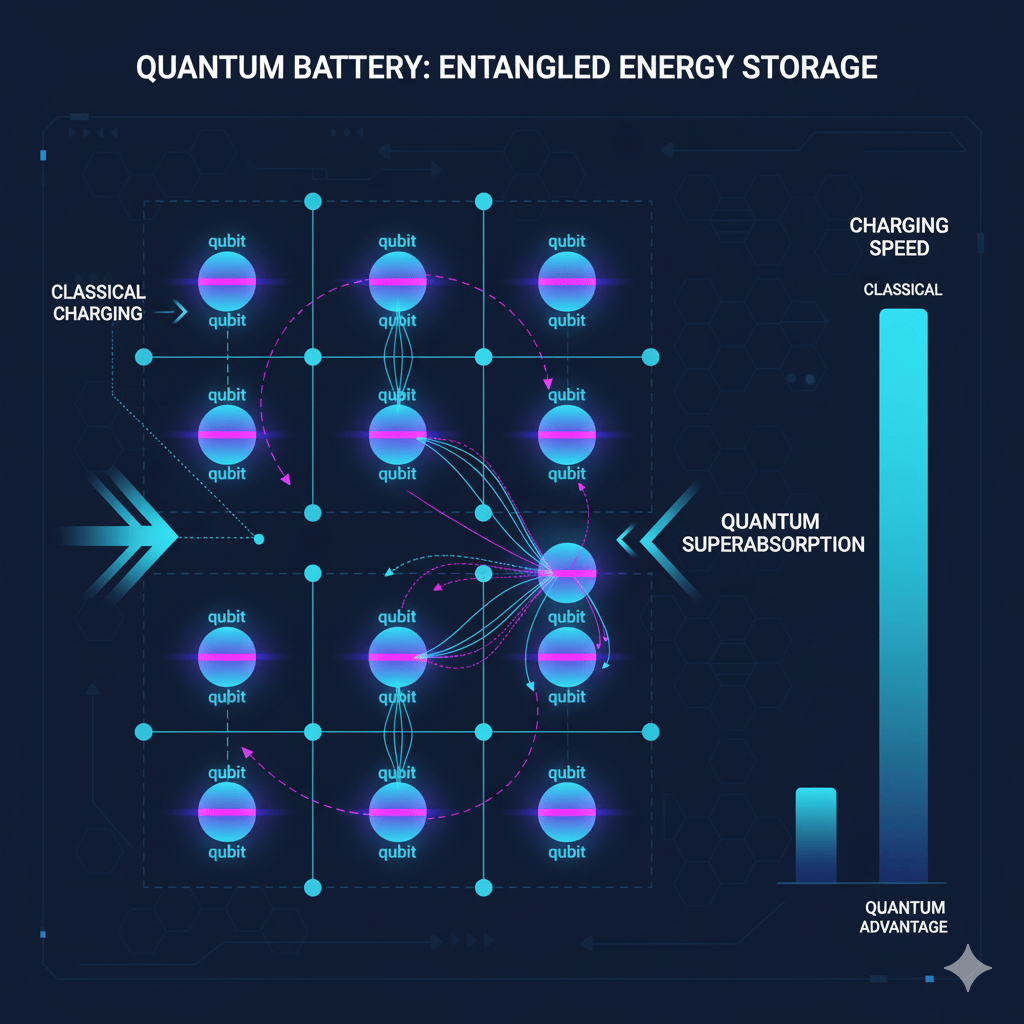Battery technology has long been a bottleneck in electronics and energy storage. Conventional electrochemical batteries have limitations in charging speed, energy density, and lifetime. Enter quantum batteries, a nascent technology that harnesses quantum mechanical phenomena (like superposition or entanglement) to potentially charge much faster, deliver bursts of power, and sustain energy more efficiently. While still largely experimental, recent breakthroughs are inching quantum batteries closer to reality.

What Is a Quantum Battery?
In contrast to conventional batteries which store energy through chemical reactions (ions moving, electrons transferred), a quantum battery stores energy in the quantum states of particles (e.g. excited energy levels of qubits). The key promise lies in quantum advantage: collective quantum effects allow charging or discharging faster than classical limits.
For instance, superabsorption is a phenomenon where multiple quantum systems can absorb energy collectively faster than individually. Similarly, entanglement can enable correlated charging in multiple units.
Recent Breakthroughs
- A prototype developed at RMIT University in Australia reportedly holds energy 1,000 times longer than prior models, making quantum batteries more stable.
- Researchers demonstrated a quantum battery model that approaches the quantum speed limit, showing measurable advantage over classical ones.
- The global market projection is robust: from about USD 18.5 million in 2024 to USD 65.4 million by 2030, reflecting high interest in this emerging domain.
- But practical challenges remain: many quantum battery prototypes lose stored energy quickly (decoherence) or suffer losses in real conditions.
Advantages Over Classical Batteries
- Faster Charging: Thanks to quantum collective effects, larger quantum batteries can charge faster than classical ones.
- Higher Energy Density (in principle): Quantum states have the potential to pack more energy per unit mass or volume, though realizing this is nontrivial.
- Burst Power & Precision Discharge: A quantum battery could deliver power very precisely and rapidly, ideal for pulsed power applications or devices demanding quick bursts.
- Reduced Wear & Degradation: Because no chemical reactions are needed, wear and cycle fatigue may be less of an issue — if stability and coherence can be maintained.
Challenges & Roadblocks
- Decoherence & Losses: Maintaining quantum states is fragile. Environmental interaction causes decoherence, collapsing superposition and entanglement, losing stored energy.
- Scalability & Stability: Moving from lab prototypes of few qubits to macroscopic, stable devices remains a major engineering hurdle.
- Control & Precision: Fine control of many interacting quantum components is challenging, requiring ultra-precise fields, isolation, and error correction.
- Integration with existing systems: Converting energy from quantum states to usable electrical current or interfacing with standard electronics is complex.
- Cost & Practical viability: The systems needed (cryogenics, isolation, shielding) are expensive and bulky. Achieving ambient temperature operation would be transformative.
Use Cases & Potential Applications
While fully mature quantum batteries are not yet available, possible early applications include:
- Sensors & Internet of Things (IoT): Low-power devices that charge fast and maintain energy over time, improving autonomy.
- Wearables & medical implants: Where charging convenience and compact power are valuable.
- Pulse power systems: For lasers, radar, or electromagnetic weapons — where bursts of high power are needed.
- Energy smoothing or backup: Assisting renewables or grid applications in smoothing spikes or bursts.
- Improving solar or photonic systems: Some designs propose quantum batteries that directly absorb photons or integrate with solar systems.
The Road Ahead & Outlook
Quantum battery research is still in the early stage — many designs remain theoretical or limited to small scales. But recent breakthroughs (e.g. RMIT prototype, speed-limit models) suggest progress is accelerating.
If researchers can overcome decoherence and scale issues, quantum batteries might first appear in niche, high-tech domains, then gradually percolate into consumer electronics.
Still, we are likely years (if not decades) from seeing quantum batteries powering smartphones or electric vehicles. But the potential is enormous — and that makes this technology one to watch.
Suggested Image Placements:
- A conceptual diagram of a quantum battery: qubits, energy states, charging paths
- A comparison chart: classical vs quantum battery properties
- A photographed prototype from RMIT or lab setting (if image license allows)

